Noel Li’s thorough and dynamic analysis of women’s sexualization in the marketing of American Apparel stands out not only in its content, but also in the palpable passion for the topic Noel displays in her writing. Her use of formal and casual language, measured and thoughtful critique, and direct appeal to her readers’ sense of responsibility as consumers works powerfully in this piece to create a cohesive and memorable investigation into the standards of both portrayals of sexual power and of consumer morality as a whole. –Hyla Maddalena ’21, Editorial Assistant
Meet American Apparel: The Pornography Producer That Also Sells Clothes
Junyang (Noel) Li ’22
Welcome to today’s episode of “Is She a Human Being or a Piece of Flesh?”, produced exclusively by American Apparel, the Los Angeles-based, 600 million-grossing clothing brand with an extensive history of sexualizing and objectifying women in their infamous advertising campaigns. Before you skip my entire post and comment on how I am just another cynical and sensitive feminist who seeks attention with clickbait titles, I would like to invite you to look at the picture below:
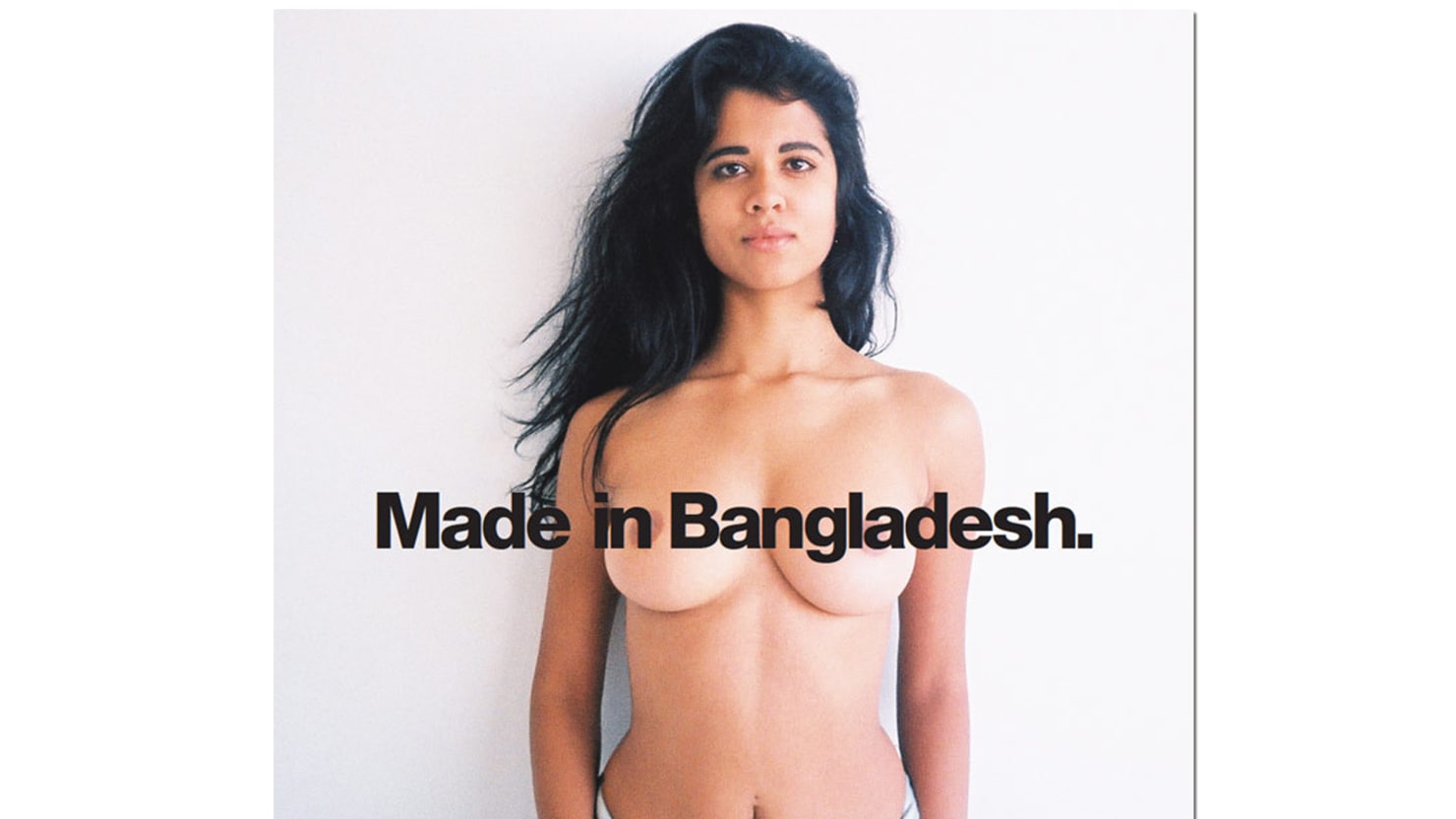
This 2014 American Apparel advertisement, featuring a topless model with the words “Made in Bangladesh” printed across her bare chest, caused quite a stir. The statement wasn’t referring to her jeans, but the model herself, a merchandiser who was born in Bangladesh and immigrated to the United States with her family at the age of 4. Although the stunt was meant to draw attention to the company’s domestic and sweatshop-free labor practices by subverting their traditional “Made in America” slogan, it commodifies the model and equates her to an inanimate good. The dehumanizing nature of this ad is undebatable. “Made in …” is a phrase most commonly used to describe a product’s place of production and can be found on virtually everything we purchase, which leads me to believe that the word choice is intentional. Apparently, American Apparel’s marketing department thought it would be a great idea to sell a product (jeans) with the portrayal of another exotic good (the Bangladeshi girl) while distracting the audience with unwarranted nudity. The image is unapologetic – it blatantly reduces a woman’s individuality to a commodity and shifts the focus from the garment to the female body, making the ad seem like an attempt to grasp attention rather than promote the barely visible jeans themselves.
The combination of overtly sexual images and a suggestive play on words is a common advertising strategy American Apparel has mastered to produce provocative ads and generate controversy. In another ad — what looks like a promotional poster — a young girl relaxes in bed while spreading her legs wide and stares at the camera with an inviting expression on her face. The words “Now Open” are followed by the fine print stating the address of a new AA store in Amsterdam, but that doesn’t conceal the sexual innuendo, especially when the visual connection between the model’s pose and “Now Open” makes it hard not to associate sex with the image. To me, this advertisement is disturbing because it captures a moment so private and intimate that it would otherwise be inappropriate if displayed in public, let alone presented in a male-centered perspective where the girl becomes a vulnerable and voyeuristic object.
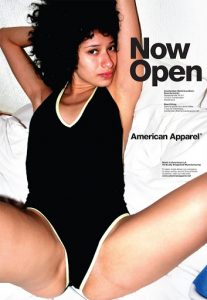
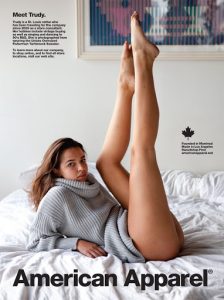
Over the years, pseudo-candid, snapshot-style, and over-the-top sexual imagery has become a hallmark of American Apparel campaigns. From the half-naked girl in a grey sweater that lifts up her legs, to the anatomy textbook-style body shots of the nameless model in a black bodysuit and thigh-highs, women are portrayed as gratuitously raunchy and readily available for public speculation and sexual conquest. In all these photos, our eyes are drawn away from the clothing, which shows that they are selling something else packaged in the deliberately provocative and somewhat grotesque imagery. Although American Apparel sells rather conventional clothing, they deliver an irreverent social message in campaigns that are hyper-sexualized to the point of being vulgar. The message basically says: I know this makes you uncomfortable, but I don’t care. The defiance is something young people, who make up the majority of AA’s customer base, can potentially identify with – maybe wearing the clothing of a brand that flaunts their sexual advertising makes you some sort of a daring rebel too.
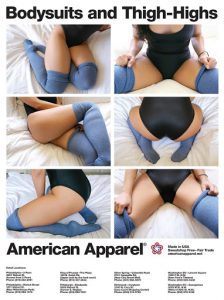
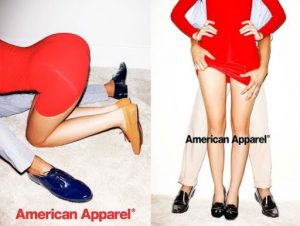
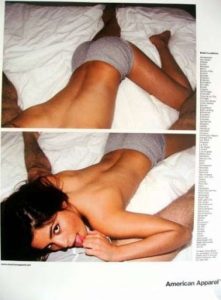

In the lens of American Apparel, the female body is frequently dominated and divided while active facial expressions or any sign of individual agency are eliminated. This is amplified in a series of pictures where female degradation is complemented by a male presence, usually in the position of control. Whether by grabbing the girl by the thighs and rolling up her dress or lying in bed and enjoying anonymous fellatio, the men in AA campaigns assert their dominance with their body language and receive pleasure effortlessly. The invasive misogyny can be spotted even with non-sexual garments such as plaid shirts; while the male model is shown wearing the shirt in a staid, unassuming manner, the female model has to strike a provocative and semi-pornographic pose to fulfill the same objective.



Aside from the egregiously over-sexualized imagery, American Apparel also plays with the pedophilic element and purposefully showcases young, innocent looking girls in suggestive and exploitative contexts. I mean, look at these pictures! I cannot be the only person who thinks they could come from an underage pornography studio. AA’s “Back to School” campaign borders on dangerous, as a featured young model bends over in a plaid skirt with her butt and underwear showing, in what amounts to an up-skirt shot. As if we needed more reinforcement of the sexualization of teenage girls, two of the campaign’s products are called the “Lolita Skirt” and the “Lolita Top”, names which clearly pay homage to the sexualized schoolgirl of Vladimir Nabokov’s novel. Although the brand tried to take advantage of the grey area and argued that “teenage” encompassed ages that fall before and after the age of consent, the campaign was banned in the U.K due to its damaging implications — implications that highlight the brand’s bold and defiant image. Even with the popular “sex sells” strategy as justification, the message turns into “pedophilia sells” in a school setting, which is chillingly different.
But is it possible that I am being an over-analyzing feminist who is shoving her personal interpretations down everyone else’s throats? What if the images I find outrageous are actually liberating for others? Although I believe the representation of healthy sexuality is important and necessary, especially for women whose sexuality has been historically suppressed and exploited, I insist that there is a line between objectification and empowerment. Whether the woman has full autonomy makes all the difference. I would welcome images displaying diverse forms of female sexuality as long as the expression is fully within the woman’s design and volition. However, that is far from the case of American Apparel campaigns, where women are used as vessels of sex appeal and deprived of the control of their bodies. What’s even worse, the specific gestures female models are often seen in all have very heavy sexual connotations rooted in fundamentally patriarchal notions. Advertisements that focus solely on a girl’s rear area or her trapped position between a man’s legs reduce women down to little more than body parts to be claimed and conquered. For a brand like American Apparel that targets a young audience, having everything made in America just isn’t going to cut it. As a consumer, I believe in our ability to reverse certain trends and reshape misogynistic fashion brands with the paramount power of our wallets. Next time you see an American Apparel store, simply ignore it in the same way they ignore a woman’s autonomy over her own body.
Bibliography
“Gallery: Controversial American Apparel Ads Through the Years.” Daily News. www.nydailynews.com/life-style/controversial-american-apparel-ads-gallery-1.2386169. Accessed 11 Jan 2019.
Johns, Stephen. “‘Fueling Lolita Fantasies and Rampant Sexism’: American Apparel Accused of ‘Resorting to Underage Porn’ to Sell its ‘Back to School’ Range of Miniskirts.” Daily Mail. 07 August 2014. www.dailymail.co.uk/news/article-2718720/American-Apparel-resorting-porn-sell-Back-School-range.html. Accessed 11 Jan 2019.
Katebi, Hoda. “American Apparel: Three Reasons Why You Should Boycott.” Joojoo Azad. 06 April 2015. www.joojooazad.com/2015/04/american-apparel-3-reasons-why-you-should-boycott.html. Accessed 11 Jan 2019.
Recent Comments